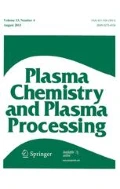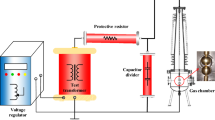Abstract
C6F12O (1,1,1,2,2,4,5,5,5-nonafluoro-4-(trifluoromethyl)pentan-3-one) is one of the most potential alternative insulation medium to SF6 due to its excellent electrical strength and environmental effect. Although several works on the insulation and decomposition properties of C6F12O have been carried out in recent years, the detailed decomposition pathways and mechanism of C6F12O haven’t been revealed up to now. A comprehensive analysis of the decomposition mechanism of C6F12O is performed through high-level quantum chemistry calculations with DFT and TST in this paper. The results show that more than ten decomposition products are formed. C4F10(a), C5F12(b), and CO can be used for evaluating slight failures. C3F8, C2F6, C2F4, C3F6, C4F10(b), C5F12(a), C6F14(a) and C6F14(b) etc. can be taken as typical products when a general failure is caused in the equipment. CF4 can be used as a basis for determining whether a serious failure has occurred in the gas-insulated electrical equipment. According to the analysis, primary decomposition products such as C4F10(a) and C5F12(b) have relatively high dielectric strength. Besides, the concentration of decomposition products of C6F12O is low to have a major impact on the overall electrical performance at normal conditions. However, the insulation properties of C6F12O gas mixtures after the prolonged operation or multiple arc extinctions deserve further investigation. In the view of human safety and environmental effect, several toxic products such as C2F4, CO, and C3F6 should be effectively managed and handled with care. This paper could provide a theoretical basis for related engineering applications.












Similar content being viewed by others
References
Zhong L, Yang A, Wang X et al (2014) Dielectric breakdown properties of hot SF6–CO2 mixtures at temperatures of 300–3500 K and pressures of 0.01–1.0 Mpa. Phys Plasmas 21(5):3077–3859
Dervos CT, Vassiliou P, Mergos JA (2007) Thermal stability of SF6 associated with metallic conductors incorporated in gas insulated switchgear power substations. J Phys D Appl Phys 40(22):6942–6949
Fu Y, Wang X, Yang A et al (2019) The decomposition pathways of SF6 in the presence of organic insulator vapors. Plasma Chem Plasma Process 40(2):449–467
Wan H, Moore J, Olthoff J et al (1993) Electron scattering and dissociative attachment by SF6 and its electrical-discharge by-products. Plasma Chem Plasma Process 13(1):1–16
Fu Y, Yang A, Wang X et al (2019) Theoretical study of the decomposition mechanism of C4F7N. J Phys D Appl Phys 52:245203
Zhong L, Wang J, Wang X, Rong M (2018) Calculation of electron-impact ionization cross sections of perfluoroketone (PFK) molecules CxF2xO (x=1 − 5) based on Binary-Encounter-Bethe (BEB) and Deutsch-Märk (DM) methods. Plasma Sources Sci Technol 27(9):095005
Li Y, Zhang X, Zhang J, Xiao S, Xie B, Chen D, Gao Y, Tang J (2019) Assessment on the toxicity and application risk of C4F7N: a new SF6 alternative gas. J Hazard Mater 368:653–660
Tatarinov A, Bilera I, Avtaeva S et al (2015) Dielectric barrier discharge processing of trans-CF3CH=CHF and CF3C(O)CF(CF3)2, their mixtures with air, N2, CO2 and analysis of their decomposition products. Plasma Chem Plasma Process 35(5):845–862
Zhang X, Li Y, Tian S, Xiao S, Chen D, Tang J, Zhuo R (2017) Decomposition mechanism of the C5-PFK/CO2 gas mixture as an alternative gas for SF6. Chem Eng J 336:36–48
Xu W, Jiang Y, Ren X (2016) Combustion promotion and extinction of premixed counterflow methane/air flames by C6F12O fire suppressant. J Fire Sci 34(4):289–304
Mantilla JD, Gariboldi N, Grob S (2014) Investigation of the insulation performance of a new gas mixture with extremely low GWP[C]. IEEE Electr Insul Conf 2014:469–473
Sauers I (1988) By-product formation in spark breakdown of SF6/O2 mixtures. Plasma Chem Plasma Process 8(2):247–262
Zeng F, Zhang M, Yang D, Tang J (2018) Hybrid numerical simulation of decomposition of SF6 under negative DC partial discharge process. Plasma Chem Plasma Process 39:205–226
Zhang X, Tian S, Xiao S, Deng Z, Li Y, Tang J (2017) Insulation strength and decomposition characteristics of a C6F12O and N2 gas mixture. Energies 10(8):1170
Zhong L, Ji S, Wang F, Sun Q, Chen S, Liu J (2019) Theoretical study of the chemical decomposition mechanism and model of sulfur hexafluoride (SF6) under corona discharge. J Fluor Chem 220:61–68
Fu Y, Yang A, Wang X, Murphy A, Li X, Liu D (2016) Theoretical study of the neutral decomposition of SF6 in the presence of H2O and O2 in discharges in power equipment. J Phys D Appl Phys 49(38):385203
Zhong L, Xu J, Wang X et al (2019) Electron-impact ionization cross sections of new SF6 replacements: a method of combining Binary-Encounter-Bethe (BEB) and Deutsch-Märk (DM) formalism[J]. J Appl Phys 126(19):193302
Zhong L, Wang J, Xu J, Wang X, Rong M (2019) Effects of buffer gases on plasma properties and Arc decaying characteristics of C4F7N–N2 and C4F7N–CO2 Arc Plasmas. Plasma Chem Plasma Process 39(6):1379–1396
Zhang X, Li Y, Xiao S (2017) Theoretical study of the decomposition mechanism of environmentally friendly insulating medium c3f7cn in the presence of H2O in a discharge. J Phys D Appl Phys 50(32):325201
Zhong L, Rong M, Wang X, Wu J, Han G, Wu Y (2017) Compositions, thermodynamic properties, and transport coefficients of high-temperature C5F10O mixed with CO2 and O2 as substitutes for SF6 to reduce global warming potential. AIP Adv 7(7):053506–54473
Fu Y, Wang X, Li X (2016) Theoretical study of the decomposition pathways and products of C5-perfluorinated ketone (C5 PFK). AIP Adv 6(8):085305
Waterland R, Dobbs K (2007) Atmospheric Chemistry of Linear Perfluorinated Aldehydes: Dissociation Kinetics of CnF2n+1 CO Radicals. J Phys Chem A 111(13):2555–2562
Wang F, Dun Q, Chen S, Zhong L, Fan X, Li L (2019) Calculations of total electron impact ionization cross sections for fluoroketone and fluoronitrile. IEEE Trans Dielectr Electr Insul 26(5):1693–1700
Frisch MJ, Trucks GW, Schlege HB, Scuseria GE, Robb MA, Cheeseman JR, Scalmani G, Barone V, Mennucci B, Petersson GA, Nakatsuji H, Caricato M, Li X, Hratchian HP, Izmaylov AF, Bloino J, Zheng G, Sonnenberg JL, Hada M, Ehara M, Toyota K, Fukuda R, Hasegawa J, Ishida M, Nakajima T, Honda Y, Kitao O, Nakai H, Vreven T, Montgomery JA Jr, Peralta JE, Ogliaro F, Bearpark MJ, Heyd J, Brothers EN, Kudin KN, Staroverov VN, Kobayashi R, Normand J, Raghavachari K, Rendell AP, Burant JC, Iyengar SS, Tomasi J, Cossi M, Rega N, Millam NJ, Klene M, Knox JE, Cross JB, Bakken V, Adamo C, Jaramillo J, Gomperts R, Stratmann RE, Yazyev O, Austin AJ, Cammi R, Pomelli C, Ochterski JW, Martin RL, Morokuma K, Zakrzewski VG, Voth GA, Salvador PA, Dannenberg JJ, Dapprich S, Daniels AD, Farkas Ö, Foresman JB, Ortiz JV, Cioslowski J, Fox DJ (2009) Gaussian 09, Revision A.02. Gaussian Inc., Wallingford
Grubbs G II, Dewberry C, Cooke S, Lin W (2010) The shape of perfluorobutyryl fluoride, C3F7COF, in the gas phase. J Mol Struct 973(1–3):190–193
Luo Z, Han F, Tang B, Zhang L, Liu C, Liang Q, Zhu L, Zhang J (2018) Optical properties and decomposition mechanisms of SF6 at different partial discharge determined by infrared spectroscopy. AIP Adv 8(6):065107
Zhong L, Wang F, Chen S et al (2019) Influence mechanism of pressure on SF6 decomposition characteristics under AC corona discharge. IEEE Trans Dielectr Electr Insul 26(6):1989–1997
Fu Y, Rong M, Wang X, Yang A (2018) Rate constants of C5F10O decomposition reactions at temperatures of 300–3500 K. J Phys D Appl Phys 52(3):035202
Li Y, Zhang X, Tian S, Xiao S et al (2019) Insight into the decomposition mechanism of C6F12O–CO2 gas mixture. Chem Eng J 360(15):929–940
Zhang X, Li Y, Xiao S, Tian S, Deng Z, Tang J (2017) Theoretical study of the decomposition mechanism of environmentally friendly insulating medium C3F7CN in the presence of H2O in a discharge. J Phys D Appl Phys 50(32):325201
The NIST chemistry webbook https://www.nist.gov/programs-projects/nist-chemistry-webbook
Zhang X, Li Y, Xiao S, Tang J, Deng Z (2017) Decomposition mechanism of C5F10O: an environmentally friendly insulation medium. Environ Sci Technol 51(17):10127–10136
Wada J, Ueta G, Okabe S, Hikita M (2016) Dielectric properties of gas mixtures with per-fluorocarbon gas and gas with low liquefaction temperature. IEEE Trans Dielectr Electr Insul 23(2):838–847
Devins J (1980) Replacement gases for SF6. IEEE Trans Dielectr Electr Insul 15(2):81–86
Yu X, Hou H, Wang B (2017) Prediction on dielectric strength and boiling point of gaseous molecules for replacement of SF6. J Comput Chem 38(10):721–729
Brand K (1982) Dielectric strength, boiling point and toxicity of gases-different aspects of the same basic molecular properties[J]. IEEE Trans Dielectr Electr Insul 17(5):451–456
Shanghai institute of organic chemistry, Chinese Academy of Sciences. Chemistry Database [DB/OL]. https://www.organchem.csdb.cn/scdb/default.asp
Everything G (1996) Intergovernmental panel on climate change. Environ Sci Pollut Res 3(1):52–57
Rozum I, Limão-Vieira P, Eden S, Tennyson J, Mason N (2006) Electron Interaction Cross Sections for CF3I, C2F4, and CFx(x = 1 – 3) Radicals. J Phys Chem Ref Data 35(1):267–284
Christophorou L, Olthoff J, Green D (1997) Gases for electrical insulation and arc interruption: possible present and future alternatives to pure SF6. NIST Technical Note 1425
Beroual A, Haddad A (2017) Recent advances in the quest for a new insulation gas with a low impact on the environment to replace sulfur hexafluoride (SF6) gas in high-voltage power network applications. Energies 10(8):1216
Ivy D, Rigby M, Baasandorj M, Burkholder J, Prinn R (2012) Global emission estimates and radiative impact of C4F10, C5F12, C6F14, C7F16 and C8F18. Atmos Chem Phys 12(5):12987–13014
Mühle J, Ganesan A, Miller B, Salameh P, Harth C, Greally B, Rigby M, Porter L, Steele L, Trudinger C, Krummel P, O'Doherty S, Fraser P, Simmonds P, Prinn R, Weiss R (2010) Perfluorocarbons in the global atmosphere: tetrafluoromethane, hexafluoroethane, and octafluoropropane. Atmos Chem Phys 10:5145–5164
Acknowledgements
This work was supported by the National Natural Science Foundation of China (51677061) and the science and technology project of China Southern Power Grid (No. GDKJXM20170043). We sincerely appreciate the National Supercomputing Center of Changsha for providing us with computational time.
Author information
Authors and Affiliations
Corresponding author
Additional information
Publisher's Note
Springer Nature remains neutral with regard to jurisdictional claims in published maps and institutional affiliations.
Electronic supplementary material
Below is the link to the electronic supplementary material.
Rights and permissions
About this article
Cite this article
Wang, F., Liu, J., Zhong, L. et al. Theoretical Analysis of the Decomposition Pathways and Species of Environmentally Friendly Insulation Gas C6F12O Based on the DFT and TST. Plasma Chem Plasma Process 41, 133–153 (2021). https://doi.org/10.1007/s11090-020-10129-4
Received:
Accepted:
Published:
Issue Date:
DOI: https://doi.org/10.1007/s11090-020-10129-4




